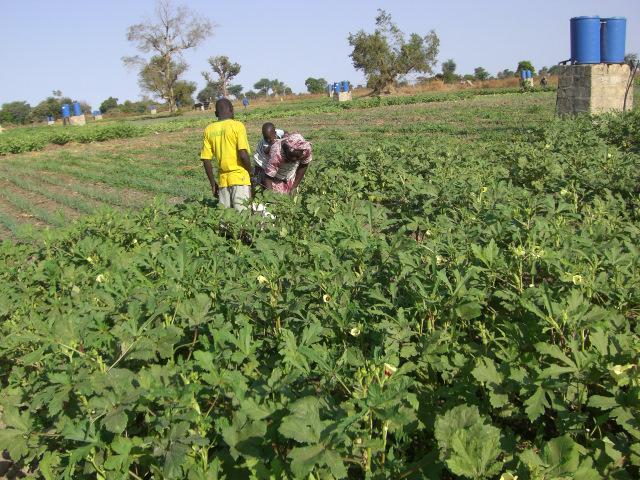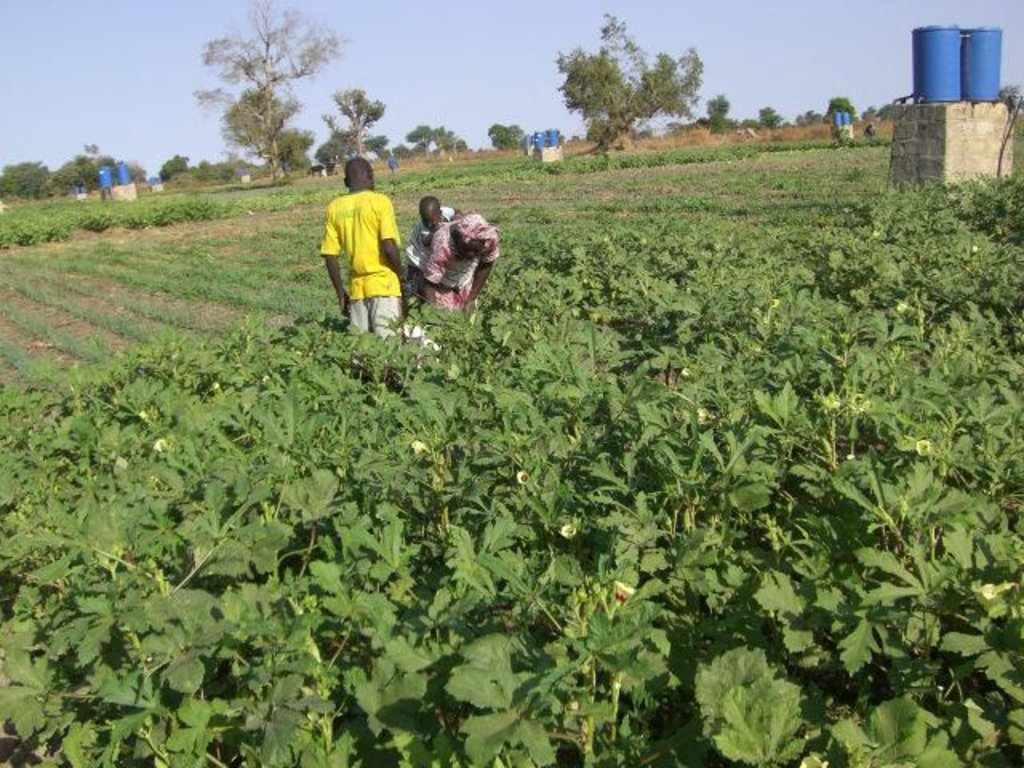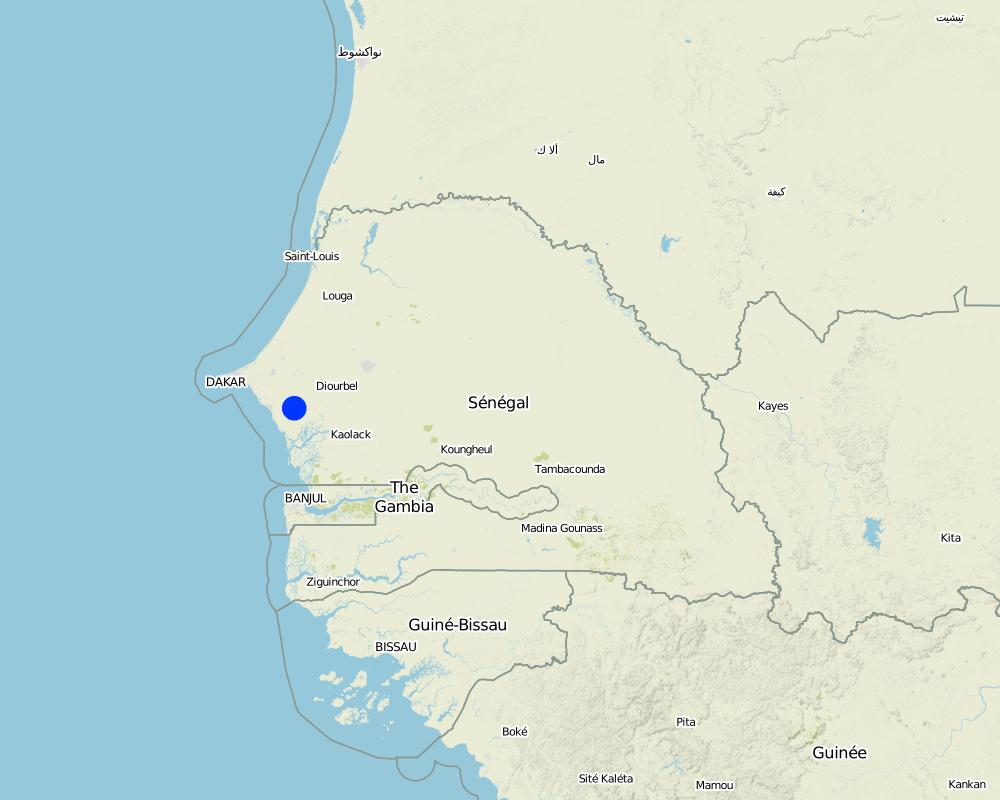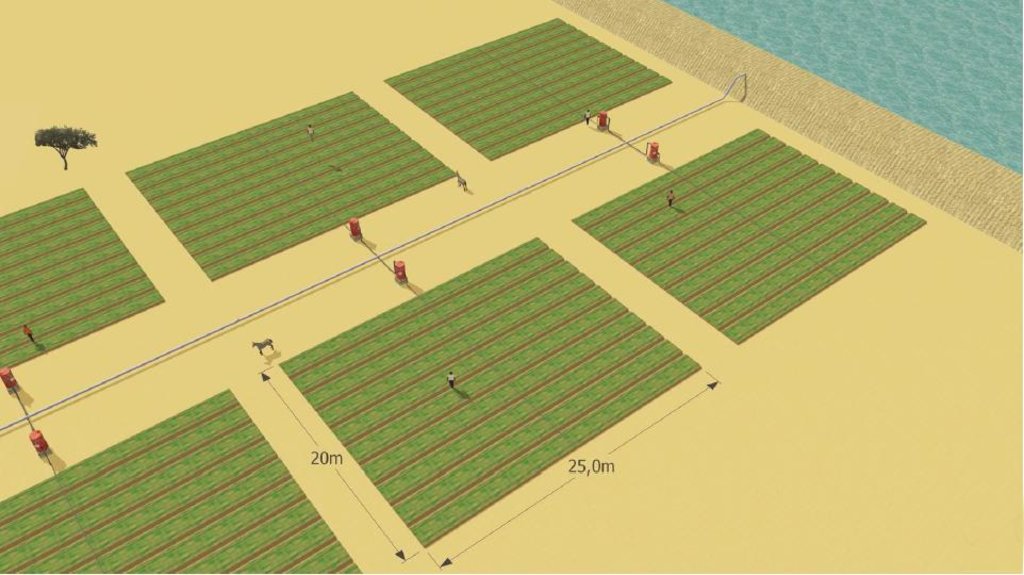African market gardens [เซเนกัล]
- ผู้สร้างสรรค์:
- การอัพเดท:
- ผู้รวบรวม: Julie Zähringer
- ผู้เรียบเรียง: –
- ผู้ตรวจสอบ: Alexandra Gavilano, Fabian Ottiger
technologies_944 - เซเนกัล
ดูส่วนย่อย
ขยายทั้งหมด ย่อทั้งหมด1. ข้อมูลทั่วไป
1.2 รายละเอียดที่ติดต่อได้ของผู้รวบรวมและองค์กรที่เกี่ยวข้องในการประเมินและการจัดเตรียมทำเอกสารของเทคโนโลยี
วิทยากรหลัก
ผู้เชี่ยวชาญ SLM:
Dov Pasternak
International Crops Research Institute for the Semi-Arid Tropics (ICRISAT)
ไนเจอร์
ชื่อของโครงการซึ่งอำนวยความสะดวกในการทำเอกสารหรือการประเมินเทคโนโลยี (ถ้าเกี่ยวข้อง)
Book project: SLM in Practice - Guidelines and Best Practices for Sub-Saharan Africa (SLM in Practice)ชื่อขององค์กรซึ่งอำนวยความสะดวกในการทำเอกสารหรือการประเมินเทคโนโลยี (ถ้าเกี่ยวข้อง)
ICRISAT (ICRISAT) - ไนเจอร์1.3 เงื่อนไขการใช้ข้อมูลที่ได้บันทึกผ่านทาง WOCAT
ผู้รวบรวมและวิทยากรหลักยอมรับเงื่อนไขเกี่ยวกับการใช้ข้อมูลที่ถูกบันทึกผ่านทาง WOCAT:
ใช่
2. การอธิบายลักษณะของเทคโนโลยี SLM
2.1 การอธิบายแบบสั้น ๆ ของเทคโนโลยี
คำจำกัดความของเทคโนโลยี:
The African Market Garden (AMG) is a horticultural production system based on low-pressure drip irrigation.
2.2 การอธิบายแบบละเอียดของเทคโนโลยี
คำอธิบาย:
According to the level of experience, market orientation or social structure of the land users, four different AMG models have been developed. This case study focuses on the “Cluster System” which is suitable for an organized group of independent vegetable producers sharing a common water delivery system. From a central source, water is distributed through a pipe network to a cluster of plots. Each farmer operates a 1,000 m2 unit, and each is equipped with an elevated 200 litre barrel and a standard irrigation kit, including a tap, filter and thick-tube drip laterals. Minimal size of an AMG unit should be 500 m2. Affordable high-quality material is used and the design and operation is simple. The barrel also serves as a fertilizer tank. A float ensures a constant pressure head. Water supply is calculated by the time needed for delivery of the daily water dosage, or through the use of water dosing valves. Producers have individual control of water use. Since the AMG requires only 1 meter pressure for operation, it can draw on low-capacity renewable energy sources such as elevated dams, solar pumps or reservoirs. To supply an area of 50,000 m2 with 8 mm/day in the hot season a 400 m3-reservoir is required. The crops are planted on elevated beds. Water mixed with urea as fertilizer is applied daily. Drip irrigation improves growing conditions for crops while at the same time saving labor, water and other inputs. AMG is promoted as a holistic management package, integrating all aspects of production, post-harvest and marketing in one system. This includes the use of improved vegetable varieties, improved crop husbandry, integrated pest management, as well as improved storage, processing and marketing of products, and improved access to inputs.
Establishment / maintenance activities and inputs: The following establishment activities are connected to this technology: 1. Build concrete reservoir. 2. Drill borehole (110 mm diameter; 12 m deep, hand drilled). 3. Install motor pump and tubes to connect well with reservoir. 4. Install drip kit with tap, filter and drip laterals (8-16 mm in diameter). 5. Establish a fence to protect the garden.
For maintenance the following activities are required: 1. Prepare elevated beds with a basic dressing of 4 kg/m2 manure and 0.1 kg/m2 NPK fertilizer biannually. 2.Add urea to irrigation water (concentration: 50-100 ppm N). 3. Operate water supply system.
Natural / human environment: AMG is spreading fast in Senegal and Burkina Faso. Up-scaling of AMG in dry West Africa will depend on access to technology, inputs, knowledge and organization, and a conducive institutional environment.
2.3 รูปภาพของเทคโนโลยี
2.5 ประเทศภูมิภาค หรือสถานที่ตั้งที่เทคโนโลยีได้นำไปใช้และได้รับการครอบคลุมโดยการประเมินนี้
ประเทศ:
เซเนกัล
ข้อมูลจำเพาะเพิ่มเติมของสถานที่ตั้ง :
Ngoyé Ndioffogor and Mbassis Tadadem
Map
×2.6 วันที่การดำเนินการ
ถ้าไม่รู้ปีที่แน่นอน ให้ระบุวันที่โดยประมาณ:
- น้อยกว่า 10 ปี (ไม่นานนี้)
2.7 คำแนะนำของเทคโนโลยี
ให้ระบุว่าเทคโนโลยีถูกแนะนำเข้ามาอย่างไร:
- ในช่วงการทดลองหรือการทำวิจัย
3. การจัดประเภทของเทคโนโลยี SLM
3.1 วัตถุประสงค์หลักของเทคโนโลยี
- ปรับปรุงการผลิตให้ดีขึ้น
- ลด ป้องกัน ฟื้นฟู การเสื่อมโทรมของที่ดิน
- สร้างผลกระทบทางด้านเศรษฐกิจที่เป็นประโยชน์
3.2 ประเภทของการใช้ที่ดินในปัจจุบันที่ได้นำเทคโนโลยีไปใช้

พื้นที่ปลูกพืช
- การปลูกพืชล้มลุกอายุปีเดียว
แสดงความคิดเห็น:
Type of cropping system and major crops comments: AMG is suitable for urban/peri¬urban areas where producers have access to credit, markets, technical support
Strong organisation in groups is important for the maintenance of the system and for access to training/backstopping
3.4 การใช้น้ำ
การใช้น้ำของที่ดินที่มีการใช้เทคโนโลยีอยู่:
- จากน้ำฝน
3.5 กลุ่ม SLM ที่ตรงกับเทคโนโลยีนี้
- การจัดการด้านชลประทาน (รวมถึงการลำเลียงส่งน้ำ การระบายน้ำ)
- มาตรการหลังเก็บเกี่ยว
3.6 มาตรการ SLM ที่ประกอบกันเป็นเทคโนโลยี

มาตรการจัดการพืช
- A7: Others

มาตรการอนุรักษ์ด้วยการจัดการ
- M2: การเปลี่ยนแปลงของการจัดการหรือระดับความเข้มข้น
3.7 รูปแบบหลักของการเสื่อมโทรมของที่ดินที่ได้รับการแก้ไขโดยเทคโนโลยี

การเสื่อมโทรมของน้ำ
- Ha (Aridification): การเกิดความแห้งแล้ง
- Hg (Change in groundwater): การเปลี่ยนแปลงของน้ำบาดาลหรือระดับน้ำในแอ่งน้ำบาดาล
แสดงความคิดเห็น:
Main type of degradation addressed: Ha: aridification, Hg: change in groundwater / aquifer level
3.8 การป้องกัน การลดลง หรือการฟื้นฟูความเสื่อมโทรมของที่ดิน
ระบุเป้าหมายของเทคโนโลยีกับความเสื่อมโทรมของที่ดิน:
- ป้องกันความเสื่อมโทรมของที่ดิน
4. ข้อมูลจำเพาะด้านเทคนิค กิจกรรมการนำไปปฏิบัติใช้ ปัจจัยนำเข้า และค่าใช้จ่าย
4.1 แบบแปลนทางเทคนิคของเทคโนโลยี
ข้อมูลจำเพาะด้านเทคนิค (แบบแปลนทางเทคนิคของเทคโนโลยี):
Cluster system with several AMG plots connected to a central water source - in this case a small elevated dam
Technical knowledge required for field staff / advisors: high
Technical knowledge required for land users: high
Main technical functions: increase of groundwater level / recharge of groundwater, water spreading
Agronomic measure: drip irrigation
ผู้เขียน:
ICRISAT, Niamey, Niger
4.2 ข้อมูลทั่วไปเกี่ยวกับการคำนวณปัจจัยนำเข้าและค่าใช้จ่าย
ระบุค่าเฉลี่ยของค่าจ้างในการจ้างแรงงานต่อวัน:
2.00
4.3 กิจกรรมเพื่อการจัดตั้ง
| กิจกรรม | Timing (season) | |
|---|---|---|
| 1. | Get inputs |
4.4 ค่าใช้จ่ายของปัจจัยนำเข้าที่จำเป็นสำหรับการจัดตั้ง
| ปัจจัยนำเข้า | หน่วย | ปริมาณ | ค่าใช้จ่ายต่อหน่วย | ค่าใช้จ่ายทั้งหมดต่อปัจจัยนำเข้า | %ของค่าใช้จ่ายที่ก่อให้เกิดขึ้นโดยผู้ใช้ที่ดิน | |
|---|---|---|---|---|---|---|
| อุปกรณ์ | Tools | Unit | 1.0 | 65.0 | 65.0 | |
| อุปกรณ์ | Drip system | Unit | 1.0 | 300.0 | 300.0 | |
| อุปกรณ์ | Oil drum | Unit | 1.0 | 56.0 | 56.0 | |
| อุปกรณ์ | Well/borehole | Unit | 1.0 | 16.0 | 16.0 | |
| อุปกรณ์ | Motor pump | Unit | 1.0 | 34.0 | 34.0 | |
| วัสดุสำหรับก่อสร้าง | Fence | Unit | 1.0 | 25.0 | 25.0 | |
| วัสดุสำหรับก่อสร้าง | PVC connections | Unit | 1.0 | 79.0 | 79.0 | |
| ค่าใช้จ่ายทั้งหมดของการจัดตั้งเทคโนโลยี | 575.0 | |||||
| Total costs for establishment of the Technology in USD | 575.0 | |||||
4.5 การบำรุงรักษาสภาพหรือกิจกรรมที่เกิดขึ้นเป็นประจำ
| กิจกรรม | ช่วงระยะเวลา/ความถี่ | |
|---|---|---|
| 1. | Prepare elevated beds with a basic dressing of 4 kg/m2 manure and 0.1 kg/m2 NPK fertilizer biannually | biannually |
| 2. | Add urea to irrigation water (concentration: 50-100 ppm N) | |
| 3. | Operate water supply system |
4.6 ค่าใช้จ่ายของปัจจัยนำเข้าและกิจกรรมที่เกิดขึ้นเป็นประจำที่ต้องการการบำรุงรักษา (ต่อปี)
| ปัจจัยนำเข้า | หน่วย | ปริมาณ | ค่าใช้จ่ายต่อหน่วย | ค่าใช้จ่ายทั้งหมดต่อปัจจัยนำเข้า | %ของค่าใช้จ่ายที่ก่อให้เกิดขึ้นโดยผู้ใช้ที่ดิน | |
|---|---|---|---|---|---|---|
| แรงงาน | Labour | Unit | 1.0 | 510.0 | 510.0 | |
| ค่าใช้จ่ายทั้งหมดของการบำรุงรักษาสภาพเทคโนโลยี | 510.0 | |||||
| Total costs for maintenance of the Technology in USD | 510.0 | |||||
แสดงความคิดเห็น:
A unit corresponds to the area irrigated by one producer (=500 m2). Establishment costs include labour inputs (2 US$ per person-day). Annual maintenance costs include labour, fuel and agricultural inputs (e.g. fertilizer, seeds; based on ICRISAT recommended rates). For a 1000m2-unit prices are doubled (except for tools and fence)
5. สิ่งแวดล้อมทางธรรมชาติและของมนุษย์
5.1 ภูมิอากาศ
ฝนประจำปี
- < 250 ม.ม.
- 251-500 ม.ม.
- 501-750 ม.ม.
- 751-1,000 ม.ม.
- 1,001-1,500 ม.ม.
- 1,501-2,000 ม.ม.
- 2,001-3,000 ม.ม.
- 3,001-4,000 ม.ม.
- > 4,000 ม.ม.
เขตภูมิอากาศเกษตร
- กึ่งแห้งแล้ง
Thermal climate class: tropics
5.2 สภาพภูมิประเทศ
ค่าเฉลี่ยความลาดชัน:
- ราบเรียบ (0-2%)
- ลาดที่ไม่ชัน (3-5%)
- ปานกลาง (6-10%)
- เป็นลูกคลื่น (11-15%)
- เป็นเนิน (16-30%)
- ชัน (31-60%)
- ชันมาก (>60%)
ธรณีสัณฐาน:
- ที่ราบสูง/ที่ราบ
- สันเขา
- ไหล่เขา
- ไหล่เนินเขา
- ตีนเนิน
- หุบเขา
ระดับความสูง:
- 0-100 เมตร
- 101-500 เมตร
- 501-1,000 เมตร
- 1,001-1,500 เมตร
- 1,501-2,000 เมตร
- 2,001-2,500 เมตร
- 2,501-3,000 เมตร
- 3,001-4,000 เมตร
- > 4,000 เมตร
5.3 ดิน
ค่าเฉลี่ยความลึกของดิน:
- ตื้นมาก (0-20 ซ.ม.)
- ตื้น (21-50 ซ.ม.)
- ลึกปานกลาง (51-80 ซ.ม.)
- ลึก (81-120 ซ.ม.)
- ลึกมาก (>120 ซ.ม.)
เนื้อดิน (ดินชั้นบน):
- หยาบ/เบา (ดินทราย)
อินทรียวัตถุในดิน:
- ต่ำ (<1%)
(ถ้ามี) ให้แนบคำอธิบายเรื่องดินแบบเต็มหรือระบุข้อมูลที่มีอยู่ เช่น ชนิดของดิน ค่า pH ของดินหรือความเป็นกรดของดิน ความสามารถในการแลกเปลี่ยนประจุบวก ไนโตรเจน ความเค็ม เป็นต้น:
Soil fertility: Low
Soil drainage/infiltration: Good
Soil water storage capacity: Low
5.6 ลักษณะของผู้ใช้ที่ดินที่นำเทคโนโลยีไปปฏิบัติใช้
แนวทางการตลาดของระบบการผลิต:
- ทำการค้า/การตลาด
เป็นรายบุคคล/ครัวเรือน:
- กลุ่ม/ชุมชน
ระดับของการใช้เครื่องจักรกล:
- งานที่ใช้แรงกาย
- การใช้เครื่องจักรหรือเครื่องยนต์
ระบุลักษณะอื่นๆที่เกี่ยวข้องของผู้ใช้ที่ดิน:
Land users applying the Technology are mainly common / average land users
5.7 Average area of land used by land users applying the Technology
- < 0.5 เฮกตาร์
- 0.5-1 เฮกตาร์
- 1-2 เฮกตาร์
- 2-5 เฮกตาร์
- 5-15 เฮกตาร์
- 15-50 เฮกตาร์
- 50-100 เฮกตาร์
- 100-500 เฮกตาร์
- 500-1,000 เฮกตาร์
- 1,000-10,000 เฮกตาร์
- >10,000 เฮกตาร์
พิจารณาว่าเป็นขนาดเล็ก กลาง หรือขนาดใหญ่ (ซึ่งอ้างอิงถึงบริบทระดับท้องถิ่น):
- ขนาดเล็ก
5.8 กรรมสิทธิ์ในที่ดิน สิทธิในการใช้ที่ดินและสิทธิในการใช้น้ำ
กรรมสิทธิ์ในที่ดิน:
- รายบุคคล ได้รับสิทธิครอบครอง
สิทธิในการใช้ที่ดิน:
- รายบุคคล
6. ผลกระทบและสรุปคำบอกกล่าว
6.1 ผลกระทบในพื้นที่ดำเนินการ (On-site) จากการใช้เทคโนโลยี
ผลกระทบทางด้านเศรษฐกิจและสังคม
การผลิต
การจัดการที่ดิน
แสดงความคิดเห็น/ระบุ:
Effective application of fertilizer with the water
รายได้และค่าใช้จ่าย
รายได้จากฟาร์ม
แสดงความคิดเห็น/ระบุ:
Due to doubled profits from vegetable production (compared to traditional irrigation methods)
ภาระงาน
แสดงความคิดเห็น/ระบุ:
Reduced workload: total workload for AMG is 11.5 man-days compared to 30 man-days in traditional irrigation system (allows people to engage in other activities or education)
ผลกระทบทางด้านเศรษฐกิจและสังคมอื่น ๆ
Production cost
แสดงความคิดเห็น/ระบุ:
Costs for drip irrigated gardens are 50% lower than for traditional irrigated gardens due to savings in labour, water and consequently in fuel
ผลกระทบด้านสังคมวัฒนธรรมอื่น ๆ
ความมั่นคงด้านอาหาร / พึ่งตนเองได้
สถาบันของชุมชน
แสดงความคิดเห็น/ระบุ:
Improved organisation (farmer associations, user groups)
SLM หรือความรู้เรื่องความเสื่อมโทรมของที่ดิน
แสดงความคิดเห็น/ระบุ:
Improved knowledge on irrigation techniques /horticulture
ผลกระทบด้านนิเวศวิทยา
วัฐจักรน้ำหรือน้ำบ่า
ปริมาณน้ำ
แสดงความคิดเห็น/ระบุ:
Water availability / reduced pressure on water resources
การระเหย
แสดงความคิดเห็น/ระบุ:
Effective use of water due to accurate and equal distribution of water at optimal rates
6.3 การเผชิญและความตอบสนองของเทคโนโลยีต่อการเปลี่ยนแปลงสภาพภูมิอากาศที่ค่อยเป็นค่อยไป และสภาพรุนแรงของภูมิอากาศ / ภัยพิบัติ (ที่รับรู้ได้โดยผู้ใช้ที่ดิน)
การเปลี่ยนแปลงสภาพภูมิอากาศที่ค่อยเป็นค่อยไป
การเปลี่ยนแปลงสภาพภูมิอากาศที่ค่อยเป็นค่อยไป
| ฤดู | increase or decrease | เทคโนโลยีมีวิธีการรับมืออย่างไร | |
|---|---|---|---|
| อุณหภูมิประจำปี | เพิ่มขึ้น | ดี |
สภาพรุนแรงของภูมิอากาศ (ภัยพิบัติ)
ภัยพิบัติจากสภาพภูมิอากาศ
| เทคโนโลยีมีวิธีการรับมืออย่างไร | |
|---|---|
| ภัยจากฝนแล้ง | ไม่ค่อยดี |
6.4 การวิเคราะห์ค่าใช้จ่ายและผลประโยชน์ที่ได้รับ
ผลประโยชน์ที่ได้รับเปรียบเทียบกับค่าใช้จ่ายในการจัดตั้งเป็นอย่างไร (จากมุมมองของผู้ใช้ที่ดิน)
ผลตอบแทนระยะสั้น:
ด้านลบเล็กน้อย
ผลตอบแทนระยะยาว:
ด้านบวกอย่างมาก
ผลประโยชน์ที่ได้รับเปรียบเทียบกับค่าใช้จ่ายในการบำรุงรักษาหรือต้นทุนที่เกิดขึ้นซ้ำอีก เป็นอย่างไร (จากมุมมองของผู้ใช้ที่ดิน)
ผลตอบแทนระยะสั้น:
ด้านบวกอย่างมาก
ผลตอบแทนระยะยาว:
ด้านบวกอย่างมาก
แสดงความคิดเห็น:
Payback period is only 6 months. Net income per farmer after all deduction is about US$ 1,000 per year. The profitability of the AMG is around double that of vegetable gardens irrigated with traditional methods
6.5 การปรับตัวของเทคโนโลยี
แสดงความคิดเห็น:
There is a strong trend towards spontaneous adoption of the Technology
Comments on adoption trend: AMG is spreading fast in Senegal and Burkina Faso. Cost reduction (e.g. alternative energy sources), collective action and intensive training / back¬stopping are very important provisions for successful adoption. Adoption trend: Up-scaling of AMG in dry West Africa will depend on access to technology, inputs, knowledge and organization, and a conducive institutional environment.
6.7 จุดแข็ง / ข้อได้เปรียบ / โอกาสของเทคโนโลยี
| จุดแข็ง / ข้อได้เปรียบ / โอกาสในทัศนคติของผู้รวบรวมหรือวิทยากรหลัก |
|---|
| AMG is a holistic management package, integrating all aspects of production, post-harvest and marketing in one system |
6.8 จุดอ่อน / ข้อเสียเปรียบ / ความเสี่ยงของเทคโนโลยีและวิธีการแก้ไข
| จุดอ่อน / ข้อเสียเปรียบ / ความเสี่ยงในทัศนคติของผู้รวบรวมหรือวิทยากรหลัก | มีวิธีการแก้ไขได้อย่างไร |
|---|---|
| Irrigated vegetable production is a capital intensive undertaking | sharing infrastructure, land and water through producer groups can cut investment costs by 60% per unit area. Set-up and operation costs further decrease if producer groups can use communally owned infrastructure and/or alternative energy sources (e.g. elevated dams, solar pumps, artesian well). |
| The AMG system is not suitable for farmers with limited access to knowledge, marketing and services | improve access to markets and training programs (for extensionists and farmers); guarantee technical assistance during 2-3 years; target the system to educated producers who make a living out of vegetable production. Set up AMG service and demonstration centres offering credit, farm inputs, marketing support, training and technical advice. |
7. การอ้างอิงและการเชื่อมต่อ
7.1 วิธีการและแหล่งข้อมูล
7.2 การอ้างอิงถึงสิ่งตีพิมพ์
หัวข้อ, ผู้เขียน, ปี, หมายเลข ISBN:
Woltering L., D. Pasternak and J. Ndjeunga. 2009. The African Market Garden: Development of an Integrated Horticultural Production System for Smallholder Producers in West Africa – Draft Submitted to Irrigation and Drainage 21-10-2009
หัวข้อ, ผู้เขียน, ปี, หมายเลข ISBN:
ICRISAT. 2009. The African Market Garden - Advanced Horticulture for the Poor (Flyer)
ลิงก์และโมดูล
ขยายทั้งหมด ย่อทั้งหมดลิงก์
ไม่มีลิงก์
โมดูล
ไม่มีโมดูล





